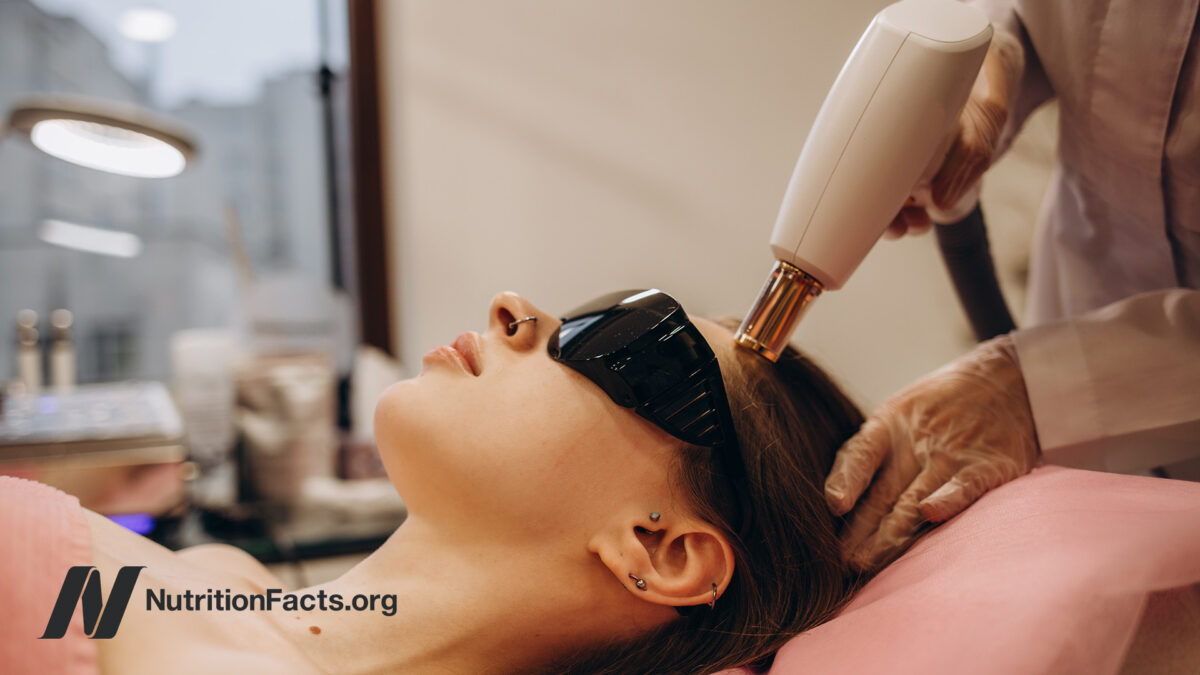Below is an approximation of this video’s audio content. To see any graphs, charts, graphics, images, and quotes to which Dr. Greger may be referring, watch the above video.
In my book How Not to Age, I discuss all the drugs, foods, supplements, and surgeries that can treat age-related hair loss. But what about non-dietary, non-drug, non-surgical interventions? Autologous platelet‐rich plasma, where concentrated portions of your own blood is repeatedly injected into your scalp, appears to have an efficacy similar to the available drugs, though the available evidence is considered insufficient to recommend it, and so remains unapproved in the U.S. or Europe for hair restoration purposes. Scalp Botox is also not recommended. The thought was that relaxing scalp muscles might improve blood flow, but when actually put to the test, actually caused hair loss in some pilot study participants. Then, there are lasers.
In the 1960’s, a Hungarian physician published the paper “The effect of laser beams on the growth of hair in mice,” detailing a serendipitous discovery that a low-powered ruby laser increased the hair growth on the shaved backs of mice. The mechanism appears to be increased blood flow. The floodgates opened when the FDA cleared the first low-level laser therapy device for age-related pattern hair loss in 2007, and now, there are clinics advertising lasers for everything from tennis elbow to “scrotal rejuvenation.”
There have been at least ten randomized, controlled trials of low-level laser therapy devices for hair loss, and the efficacy has been found comparable or even superior to the drugs. They are noninvasive, and appear to be relatively safe. Mild side effects include itching, acne, and scalp tenderness that usually resolve within two weeks. Reviews typically conclude that laser therapy may be a promising alternative to drugs and scalpels, but there remains considerable skepticism within the dermatology community, and for good reason.
Most of the laser therapy trials were funded by the manufacturers of the tested products themselves. This is true of hair loss treatments across the board, but laser studies appear particularly reticent to provide visual evidence or inquire about perhaps the most important outcome of all: patient satisfaction. When the first independent study was performed, blinded evaluations of before-and-after photographs could not detect a difference in hair density or caliber. In two studies that compared subjective satisfaction between laser and sham placebo devices, no significant difference could be found either. In other words, from the patient’s perspective, they just plain don’t work. So, while there are statistically significant improvements in hair density and thickness, there may be little clinically significant improvement.
If you want to give them a try anyway, there are at least 29 FDA-cleared devices currently on the market. There have been no head-to-head studies between them, but based on measured outcomes, there appear to be no difference between comb-style and hat-style devices––though those containing laser diodes exclusively may have an edge over devices that include a mix of both laser diodes and LED. Do not look into the light, as prolonged retinal exposure could be damaging. Thankfully, at least most cap designs have a built-in safety shut off to avoid accidental eye exposure. Otherwise, besides general safety caveats about using electrical contraptions in or around water, such devices are considered safe, though they are contraindicated for those with cancer of the scalp due to the potential for stimulatory effects.
Please consider volunteering to help out on the site.


